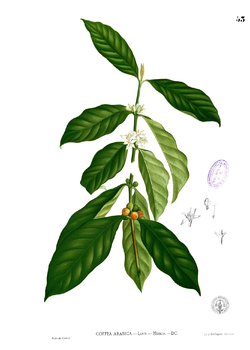Coffea (botany)
| Coffea (botany) | |
|---|---|
|
Drawing of C. arabica |
|
| Taxonomical nomenclature | |
| Kingdom | Plantae |
| Unranked | Angiosperms |
| Unranked | Eudicots |
| Unranked | Asterids |
| Order | Gentianales |
| Family | Rubiaceae |
| Genus | Coffea |
| Species | arabica |
| Common nomenclature | |
| Common names | Java, Coffee, Joe, Morning jolt |
| Constituents | |
| Active constituents | Caffeine |
Identification
Wild plants grow between 9 and 12 m (29 and 39 ft) tall, while commercial cultivars are much shorter at 3-5 m. They have an open branching system; the leaves are opposite, simple elliptic-ovate to oblong, 6–12 cm (2.4–4.8 in) long and 4–8 cm (1.6–3.2 in) broad, glossy dark green. The flowers are white, 10–15 mm in diameter and grow in axillary clusters. The seeds are contained in a drupe (though commonly called a "cherry"; the plural form is simply "cherry"—used only when referring to the fruit of C. arabica—when referring to the actual cherry fruit, the appropriate plural is "cherries") 10–15 mm in diameter, maturing bright red to purple and typically contains two seeds (the coffee seeds).
Reproduction
The coffee cherry is most viable for an optimal period of 4 months, while still viable after this period the germination rate quickly decreases and they will take significantly longer to germinate. The freshest seeds are expected to germinate in 2.5 months, although old seeds can take as long as 6. The seeds can be pre-germinated by soaking them in water for 24 hours and then, placing them within a continuously moist and well drained medium such as sand, vermiculite, or coarse fabric. Once they have germinated place them flat side down 1.25 cm deep in a light weight and porous soil and cover by sprinkling over top. The soil should then be watered daily, still careful to keep a continuously moist yet well drained water content. If germinated in favorable growing conditions the plant may be left alone after taking hold, or watered twice weekly if kept indoors.[1]
Favorable growing conditions
It is endemic to the mountainous regions of Yemen and to the southwestern highlands of Ethiopia, although it has been naturalized and cultivated in many other places. Native to mountainous terrain, it is usually grown at altitudes of 1,300 to 1,500 m , but is known to grow from sea level all the way to 2800 m above.[2]
It prefers to grow in light shade with an average temperature between 15 and 24 °C (59 and 75 °F),[3] the trees can withstand lower temperatures but will be damaged by frost, while higher temperatures will slow photosynthesis.
The plant thrives porous, low pH soil with a high nitrogen content.[1] It ideally experiences 1500-2500 mm of rain or other watering over a nine month period with a three month dry season coinciding with the harvest. This moisture stress can induce a more homogeneous flowering and thus create a well defined harvesting period, while multiple wet and dry seasons can enable multi-annual harvests.[4]
Growth timeline
C. Arabica takes roughly 7 years to fully mature, though by 2-4 years it will usually spout small white flowers which give a potent fragrance reminiscent of Jasmine blossoms. Blooms occurring on sunny days are reputed to produce more berries, though overflowering can damage the plant as it gives too much energy to the developing fruits and weakens itself, thus pruning may be necessary. The flowers only last a few days, leaving behind only the thick, dark-green leaves. The berries then begin to appear. These are as dark green as the foliage, until they begin to ripen, at first to yellow and then light red and finally darkening to a glossy deep red. At this point they are called “cherry” and are ready for picking. Ripe fruits are oblong and 1 cm long, often chosen by hand as unripe berries result in an inferior blend, though the tree may be shaken to drop the berries onto mats and later sorted. each tree can produce from 0.5 to 5.0 kg of dried beans, depending on the tree's individual character and the climate that season. The purpose for growing this plant is usually the beans inside the cherry. Each holds two locules containing the beans. The coffee “beans” are actually two seeds within the fruit; and sometimes, a third seed or one seed, a peaberry, grows in the fruit at tips of the branches. The seeds are covered in two membranes; the outer one is called the "parchment coat" and the inner one is called the "silver skin".
Active constituents
- Most strains contain around 12mg caffeine per 1g dried seed.
External links
References
- ↑ 1.0 1.1 Growing Coffee Beans at Home
- ↑ Schmitt, C. B. (2006). Montane Rainforest with Wild Coffea Arabica in the Bonga Region (SW Ethiopia): Plant Diversity, Wild Coffee Management and Implications for Conservation. Cuvillier Verlag. ISBN 9783867270434.
- ↑ Climate for Growing Arabica Coffee Beans
- ↑ Obso, T. K. (2006). Ecophysiological Diversity of Wild Arabica Coffee Populations in Ethiopia: Groth, Water Relations and Hydraulic Characteristics Along a Climatic Gradient. Cuvillier Verlag. ISBN 9783867279901.
